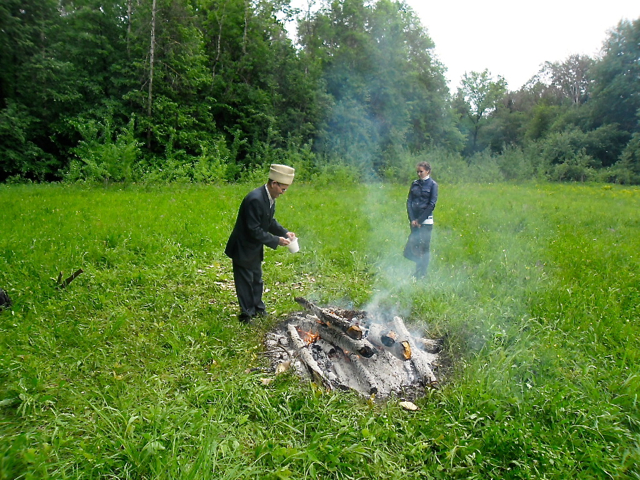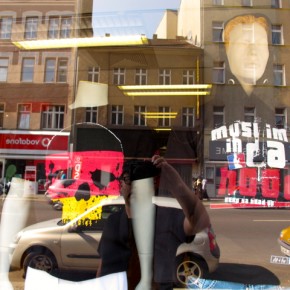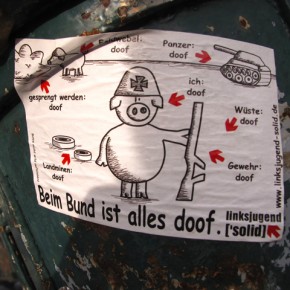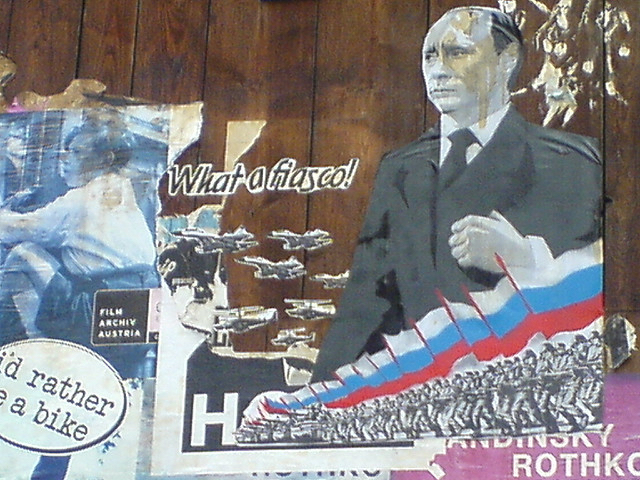The Ensai souvenir shop was, it assured passersby, the home of authentic Mari souvenirs. Inside was a jungle of multicoloured fabric, giddying geometric patterns of whites and reds, traditional costumes of the kind usually kept in dusty display cases of the national museum. Yoshkar-Ola, (“the red city,“) is the capital of Russia’s autonomous Republic of Mari El. Heavily forested and sparsely populated, it is a nondescript, provincial town, which, as I had discovered on my first visit in 2011, was increasingly defying description.
The half-finished shells of immense churches to serve the faithful in this former closed city of 240,000 were incubators for a religious revival. Faithful armies of icons stared down visitors from the windows of tourist shops. Taxi drivers hung miniature icons from their rear view mirrors – theology and potholes. “It’s time to live in Mari El!” read a banner above the national theatre. A nation shrugs. This is the post-Soviet religious revival.
On the wall of Ensai hangs an embroidered cloth with the Mari words Puru Osh Kugu Yumo Arale. Osh Kugu Yuma (the great God of light), is the most important of all deities in the Marla faith, Mari Traditional Religion. Also known as Kugurak, ‘the elder’, other deities in the pantheon are seen as different aspects of his nature.
The estimate of Mari belonging to this ancient belief system varies widely. According to an employee at Ensai, Galina, it stands somewhere between seven and ten percent of all Mari. Yet Russian Orthodox and Marla practice cannot be seen as mutually exclusive. Tthe two faiths having co-existed for centuries, and their relationship is a complex and multifaceted one. Nickolaus von Twickel, writing for the Moscow Times, reported Mari women crossing themselves after prayers in a sacred glade in the Republic’s north.
Mari pagan practice is part of a wider phenomenon amongst the Finno-Ugric peoples of Russia, who in 2001 declared the Uralic Communion together with similar Finnish and Estonian religious movements. In the troubled relationship between Estonia and Russia, the treatment of Finno-Ugric peoples in Russia – namely the Mari – has on occasion been raised by the Estonian government. The anonymity of this pagan faith on the streets of Yoshkar-Ola is not necessarily a reflection of byzantine political intrigue. Mari religion, some activists have claimed, was kicked into the long grass by an intolerant and intransigent local government. Yet the long grass and deep forests have been where this faith has endured the longest.
“Salaam Liizhe,” I say with a handshake, courtesy of a 100-rouble Mari phrasebook. (The greeting is possibly from their Muslim Tatar neighbours to the south.) I meet with some Mari acquaintances on their way to the festival of Agavairem. Several months and several more phone calls had passed since my first visit. Opportunities such as these have a habit of generating themselves, if only with a little patience and a lot of understanding. We were parked outside a supermarket on the outskirts of Yoshkar-Ola as Alyena bought eggs and bread, offerings for the ceremony.
The two Mari University students who had come along were in high spirits. Russia’s Udmurt language entry to Eurovision the night before had met and exceeded their expectations. The Udmurt, like the Mari, are Finno-Ugric. One day, thought Veronika, Mari would be heard on Eurovision too. A well-thumbed issue of the Russky Reporter was passed around. The glossy black and white photos from a recent article by Natalia Kurchatova of Udmurt and Chuvash pagan practices had drawn particular interest. These were the Gods of the Volga.
Just outside the city limits of Yoshkar-Ola, (whose name is helpfully spelt out in immense metal letters by the roadside,) lies one of the many küsotö– sacred glades scattered around Mari El. We parked by the roadside, in the shadow of the city’s name, and fittingly worked our way through the long grass to a forest, following an ill-trodden path to a forest clearing. The küsotö was fairly modes t- in many ways a welcome iconoclasm from the newly sprouting onion domes of the city’s riverbanks. Not more than thirty people had arrived. It was clear the Mari phrasebook would have its uses.
This was Agavairem, sometimes known as Lyshtash Pairem, the Mari festival celebrating the beginning of the sowing season. Its purpose is to bless the land and pray for a fruitful harvest. Eggs, pancakes, cakes with sweet cheese and kvass are commonly bought along, in brightly coloured plastic bags (of purely commercial significance) and laid in a line by the edge of the glade.
The two Karts (priests are known as Onaeng) were preparing for the ceremony, whilst the faithful were prepared for combat. “People like coming to pray in Spring and Summer. But sometimes, like today, we have less,” apologises Kart Vitaly Tanakov, shaking me by the hand “maybe because of the mosquitoes.” The Ková, the Mari babushkas, are fending them off, waving handfuls of leaves but it is a losing battle. Two of the grandmothers are less concerned, lying down in the grass in their shawls as their grandsons collect wood for the fire. “In Church, you have to stand for hours. I can’t deal with that. The glade is better. Much more comfortable.”
The fire is getting started and the two Karts have arranged their audience in a circle to discuss politics. The two babushki are quite happy where they are, thank you, so the circle moves across to accommodate them. Tanakov begins in Mari, discussing the status of the Mari Traditional Religion in the Republic. Most Mari here are Chi Mari, or nonbaptised, and generally more distant from Orthodox Christian influence.Tanakov feels that the specifically Chi Mari strand of Mari paganism does not enjoy the same representation as a recognised religion enjoyed by other Mari pagan movements.
However, he has a challenger. With a thick moustache and thicker accent, he steps into the ring and takes the Kart to task; swerving to avoid theological potholes and switching wildly between Russian and Mari. Saved by the bell (or rather an axe and hammer struck together by the second Kart,) the circle breaks up and forms two lines as the ceremony begins.

Lit candles stand to attention in the loaves of bread on the grass, and mosquitoes express interest in the pancakes and bowls of kvass, allowing those at prayer some respite. Osh Kugu Yuma is kind today. The Kart with the axe and hammer fetches a half-burning log from the bonfire (with his hands) and smoke wafts over the food. The mosquitoes flee, and he repeats kumalyshmut, the sacred blessings. Vitaly stands at the head of the congregation, repeating the prayers and every so often removing his felt cap- which today only the Karts wear, in deference to the thick green forest before him.
The axe and hammer strike after each prayer, and the congregants stand with palms turned outwards. At some points, they kneel, at others, prostate themselves with heads on the ground towards the forest. Occasionally I can hear some furtive muttering. Alexei is Mari, a student from the Mari State University, and it’s his first time attending prayers. He turns out his palms, ever so slowly, and kneels down on the wet grass. “Alyosha,” whispers his girlfriend, still standing, “you don’t know what you’re doing!”
The food is offered to the fire. A spoonful of Kvass, bread, eggs, and pancakes disappear one by one into the inferno. “Fire, “explains Tanakov, “is a gateway to the other side,” Tul Yumo, the God of Fire. A female deity in Mari mythology Tul Ava, is said to be represented by a man in a red coat, offering his assistance in clearing the forest for crops. Tanakov crosses to the edge of the glade, accepts donations and gives blessings to the congregation. The crowd has dispersed and the second Kart is offering the remainder of the food to the congregation, who in turn offer it to one another.

“Shóchynzho te kushéch ulydá?”(Where are you from?). A kind, aged face beams at me and pancakes are pressed into my hands. It transpires that I can’t speak Mari. The immediate assumption is that I must be Estonian, Finnish, or Hungarian. Finno-Ugric brotherhood. Few foreigners, and increasingly fewer Mari, can speak Mari at all (though there have been some exceptions.)
People are eager to explain their view of their faith to an outsider.“I was christened when I went to St. Petersburg with my parents, but it doesn’t mean anything,” says Dasha “so I consider myself Chi Mari.” Lyubov is in her sixties and has travelled from the village of Suslonger to be here. “I’m not even Christened,” she says. “Some priests say if you go to prayers in the glades, you’re not welcome in Church. But I know where I’d rather be.” I look back at the two babushki. Awoken from their slumber they are enjoying a swing which has been set up on the edge of the glade. There are clear advantages to the Chi Mari.
How, I have been wondering, did the Mari keep their faith during the anti-religious campaigns of the Soviet era. More importantly, how did they manage to resurrect it? Lyubov is disarmingly curt.
“Some of us forgot. Others went to pray at night, when nobody watched.”
“We learnt how to pray again, from our souls. We didn’t need holy books.”
Away to the other side of the glade, the men have started a race- each sprinting to a wooden pole at the edge of the glade and back. The fire has begun to die down, and a slight breeze has picked up, blowing its acrid smoke towards us and our mosquitoes. Another game has begun – jumping over the hot embers and burning firewood. These are customs on Agavairem. Roots lie deep here, the Kart, Vitaly Tanakov told another journalist attending the same festival. The ecological consciousness of the Mari religion prohibited the sale of timber. Such an ethically and ethnically based approach to profit would meet with a standing ovation in many cities, yet most people in Mari El hardly have the luxury of pursuing it; timber is one of the Republic’s main exports.
Alcohol and Tobacco are met with similar disdain.
“Hard spirits came with the Russians. Until then, Mari never drank anything of the sort- maybe only Kvass and Medovukha [honey beer]. A Chi Mari shouldn’t drink and shouldn’t smoke. Of course, many do, but a Kart should never.” Tanakov describes the Mari relationship to drink as an Alcoholic Genocide.
A salad of letters and booklets in Russian and Mari has been set up on a small wooden table. The contents are at times mysterious. Detailed diagrams of Yumo’s relationship to his children appear on every few pages, arrows and dotted lines showing transmissions and relationships between the heavens and a quaint series of smiling stick figures. The text, meanwhile, reflects in places part of what seems a suspicion of Christianity. The Faith of Our Ancestors: Paganism, by a certain Klimenty Yuadarov notes that:
Paganism is a natural religion, in which humanity is simply a component of nature, on the periphery of the universe. Man does not cultivate nature, but cultivates himself on the path towards it. Paganism was strongly associated with the communal structure of life, contributing to the continuity of distinct groups of people and their protection from extinction. This spiritual culture was handed down from generation to generation by word of mouth- that is, it lived in oral form.
Christianity, by contrast, assumes the primacy of man over nature, ‘Me’, the individual and man in general as the source of all comprehensive information, the basis of all existence- the dominance of the individual. […] Yumo is the last resort against this fetishisation, this anthropomorphised view of the supreme deity, which emerged in Christianity, Buddhism, and Confucianism.
The author is impassioned, but his views are by and large benign. Vitaly Tanakov, however, knows the price which can be paid for inflaming Orthodox religious sensibilities, somewhat tested in Russia as of late. After a legal case beginning in 2006, his pamphlet Onaeng Oyla (“A Priest Speaks”) was accused in March 2009 of “inciting ethnic religious and racial enmity.” It was noticeable in its absence among those on sale, and it also appears unavailable on the Internet – though MariLeaks, a website which apparently once hosted the document, seems to have been hacked (Yulla, another, less controversial text of Tanakov’s, is available in Russian online).
The priest began to speak; and on the subject he was obliging. He had, he stressed, simply written what he believed to be the truth about the relationship between the Mari traditional religion and Russian Orthodoxy. Although there were Mari religious groups officially registered with the state, he felt that the state exercised a lot of its power through religious organisations and was suspicious of those who actively rejected them. In his view, the lines between dissent and treason had been blurred – had they had even existed.
“Christians can worship Christ. Wonderful. Please do. But he was still a man, even if a holy one. We prefer the divine.” Earlier on, they had prayed deeper into the forest, but things had changed due to ‘intrigue’ with the authorities about which I dare not speculate. These were realms of conversation even the greatest Mari phrasebooks were ill prepared for.
The priest had spoken long enough, and before parting gave me a copy of one of his pamphlets, Believe the Living Word, attributed simply to ‘Onaeng’. The primordial, timeless origins of Mari reflect its unique significance to paganism, he claims. Lexical similarities shared by Mari and Sanskrit are repeated time and time again, a comparison also drawn between the latter and Lithuanian.
We walked out of the glade, through the long glass and onto the tarmac, in the shadow bearing the name of the Red City. With no traces and no clues of the Chi Mari by the roadside, it could be easy to forget them, yet I am certain I will not
I returned to Yoshkar-Ola with a Chi Mari family and their ten year old son. Most of all, the pancakes had met with his approval, said his parents. We drove on through the city centre, the one working headlight of their Lada winking at the onion domes knowingly.
It took three and a half hours past lakes and pines to reach Kazan and the Volga.
The priest speaks. Yet the forests remain remarkably quiet.
Photographs courtesy of the author






Very interesting article. Thank you.
How fascinating to learn about the Mari Pagan religion. I am writing a fictional story about a young man who meets and falls in love with a young lady who is a Mari. I try to describe the Mari people, their long history and struggles with Russian anti religion, Christian assaults on Paganism AND the modern neo-pagan cults which often bring discredit to the real and ancient Mari Pagan religion.
I need information on :The transformed, “half-men, half-god” beings called “Kepemers”.
John at jandydh@gmail.com